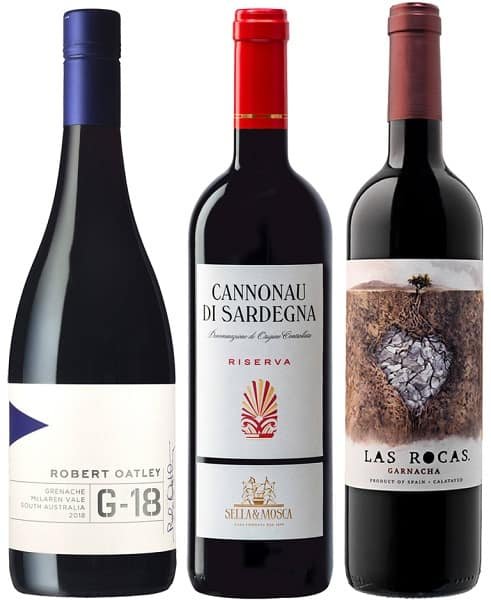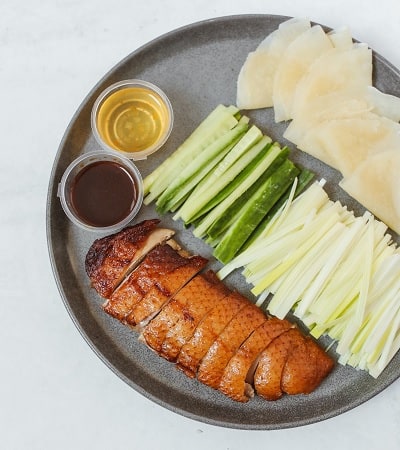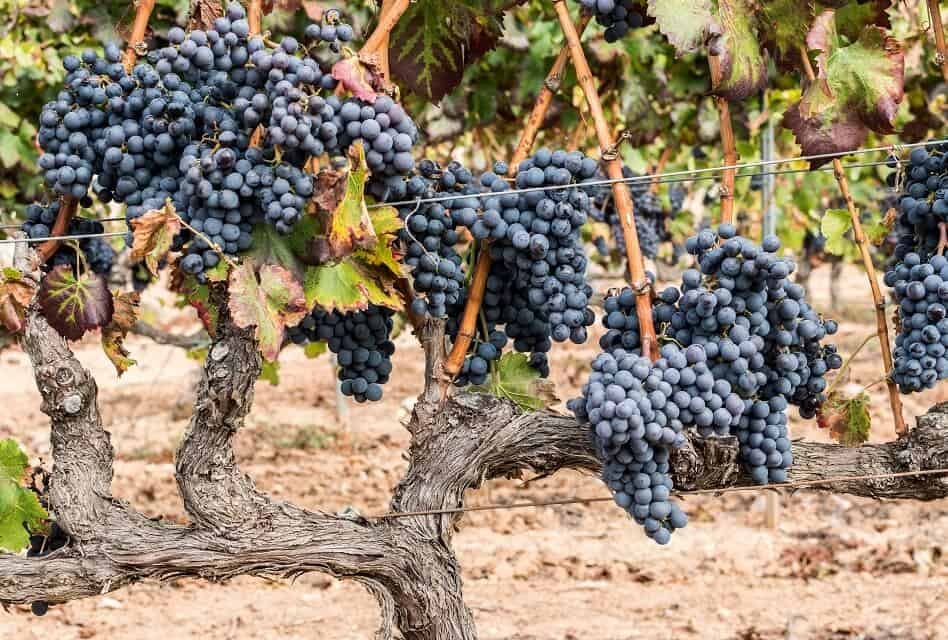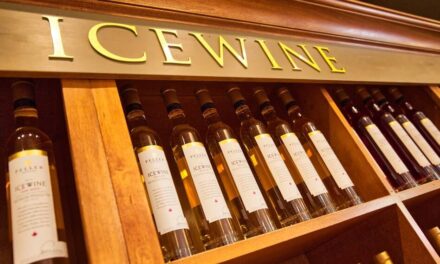Wine grapes are extremely versatile, not only in taste but also in resilience and adaptability. Many are sensitive to heat, wind, and other climatic influences. Grenache is different. The Spanish varietal can stand even in the hottest climates and still produces delicious wines.
Grenache (or Garnacha) is a red wine varietal that produces dry wines with high alcohol volumes. They are rather low in tannins and acidity, though. The grape belongs to the world’s most planted varieties. It is cultivated mainly in regions with hot and dry climates in Spain, France, California, Australia, and South Africa.
You can find many pure Grenache wines, both red and rosé, from around the world. Besides, the variety is used to make blends, such as GSM wines. In the following article, we’ll discuss the most famous Grenache wines.
WHAT MAKES GRENACHE GRAPES SPECIAL?
Grenache is widely planted around the world because it grows well, even in extreme conditions. The vines tolerate most soil types, and due to their strong trunks and stems, they are resilient to strong winds. As a late-ripening varietal, regions with hot and sunny climates and long summers are ideal.
The relatively big grapes grow in tight clusters, making them vulnerable to diseases like grey rot or downy mildew. Especially in wet climates, that might be a problem for vintners. Thus, dry regions are much better suited for Grenache grapes.
Red Grenache (Grenache Noir) is also known as Garnacha in Spain and Latin America. Besides, vintners also use white Grenache Blanc or Grenache Gris grapes to produce great white wines.
HOW DOES GRENACHE WINE TASTE?
Pure Grenache wines have low to medium levels of tannins and acidity. Nevertheless, they tend to be in the medium-bodied category because they have significant alcohol volumes. Typically, Grenache features bright fruit flavors, including cherry, raspberry, strawberry, cherry, and plum. Besides, they can have spicy aromas such as anise, black pepper, or cinnamon. When produced in Old World wine countries, they often offer notes of citrus rind, dried herbs, and tobacco.
WHERE DOES GRENACHE COME FROM?
Grenache originated in western Europe. More specifically, it came from an area that today includes parts of eastern Spain and southern France, including the Aragón region.
The hot and dry Mediterranean climate favored the growth of this varietal, so winemakers in neighboring regions started to adapt it in the medievals. Especially the expansion of the Crown of Aragón that started in the 12th century favored the spread of Grenache. It first made its way to Catalonia and other regions in southern Spain and later to Italy and numerous Mediterranean islands like Corsica and Sicily. Over the centuries, Croatian and Greek vintners introduced it to their home countries, too. Starting in the 18th century, Grenache became popular in the New World of wine as well, especially in California and Australia.
Today, Grenache is ranked No. 7 in the world’s most planted grapes, with more than 400,000 acres (163,000 hectares) of vines. The top producers are France, Spain, Italy, and the United States. Other noteworthy countries with significant plantings include Australia, Greece, Morocco, and South Africa.
WHICH WINES ARE MADE FROM GRENACHE?
Thousands of wines worldwide are made from Grenache grapes, either purely or blended with other varieties. Let’s discuss the best and most famous of them.
Aragon Wines
As Aragón is supposedly the home of Garnacha, it’s no surprise that the region still is the biggest producer of these grapes in Spain. With up to 100 years of age, its Garnache vines are the oldest in the world.
Of course, Aragón has some great wines to offer. Most of them are single-variety wines made from 100% Garnacha. The best come from the following subregions:
- Calatayud DOP is the region with the highest-altitude vineyards in Spain. Its wines are full-bodied and bold. The most precious of them carry the Calatayud Superior label. The grapes for these wines come from at least 50-year-old vines. If you ever get your hand on one of these rare bottles, you should grab it.
- To the northeast of Calatayud, you can find the Cariñena DOP. This subregion has two faces: On the one hand, many big companies bulk-produce heavy alcoholic wines primarily for blending. On the other hand, some small estates focus on high-quality wines, typically made from a blend of Garnacha, Cabernet Sauvignon, Merlot, or Syrah. They spend a significant time in oak barrels.
- In the Campo de Borja DOP, vines are typically 30+ years old. Another interesting fact is that many vintners dry their grapes in the sun for a short time before processing them. This procedure results in highly concentrated and very aromatic wines.
Priorat Wines
Grenache is also an essential ingredient in wines from Priorat. This region in the Eastern part of Spain is one of only two wine regions with a DOCa label which is the highest quality label for Spanish wines (the other one is Rioja).
The area is famous for producing excellent red, white, and rosé wines. About 40% of all plantings in Priorat are Garnacha grapes, and logically pure red wines made from this variety are the region’s signature wines.

Priorat Wine Region
But you can also find fantastic blends made from Garnacha, Carignan (Cariñena), Cabernet Sauvignon, Merlot, or Syrah that remind many wine lovers of Bordeaux wines. Both pure and blended wines spend several months aging in oak.
The pure Garnacha wines feature bright fruit flavors as well as intense spicy notes. They are relatively strong, with ABVs of 14 to 15%, and in contrast to styles from other regions, they also have significant levels of tannins.
These Priorat blends are worth testing:
Bodegas Mas Alta La Basseta 2006
- type: red, still, Vintage
- origin: Spain, Priorat
- varietal: Carignan, Garnacha, Merlot, Syrah
- alcohol: 14.5%
Bodegas Mas Alta Romani La Basseta 2017
- type: red, still, Vintage
- origin: Spain, Priorat
- varietal: Cabernet Sauvignon, Carignan, Garnacha
- alcohol: 14.5%
Clos Figueres Font de la Figuera Priorat 2018
- type: red, still, Vintage
- origin: Spain, Priorat
- varietal: Cabernet Sauvignon, Carignan, Garnacha, Monastrell, Syrah
- alcohol: 15.0%
GSM Wines
One of the world’s most common ways to combine grapes is the GSM blend. The abbreviation GSM stands for the three varietals Grenache (Noir), Syrah, and Mourvèdre. All of them are red varieties, and they add different characteristics to a wine:
- Grenache usually is the dominant grape. It contributes fruity as well as spicy aromas and body to the wine.
- Syrah adds more fruits, spicy and smoky notes, and also an intense color.
- Mourvèdre contributes structure and elegance together with a good level of tannins.
The first to create GSM wines were French winemakers in the Rhône Valley. And the region is still home to some of the best GSM blends, namely Châteauneuf du Pape wines. While local vintners also produce white wines, red GSM blends are the appellation’s most prestigious wines. They are bold, tannic, and full of fruity flavors when young. With age, they develop spicy, smoky, and herbal aromas.
The following bottles are worth opening:
Domaine du Vieux Telegraphe Chateauneuf-du-Pape La Crau 2019
- type: red, still, Vintage
- origin: France, Rhône Valley
- varietal: Cinsault, Grenache, Mourvèdre, Syrah
- alcohol: 14.5%
Chateau Fortia Cuvee du Baron Chateauneuf-du-Pape 2018
- type: red, still, Vintage
- origin: France, Rhône Valley
- varietal: Grenache, Mourvèdre, Syrah
- alcohol: 14.5%
Guillaume Gonnet Chateauneuf du Pape Bel Ami 2019
- type: red, still, Vintage
- origin: France, Rhône Valley
- varietal: Cinsault, Grenache, Mourvèdre, Syrah
- alcohol: 14.5%
Besides the original from France, you can find plenty of great GSM wines from around the world. In the following paragraphs, we will briefly discuss the most noteworthy of them.
California
In California, GSM wines are well-known as well. And due to the different microclimates in the Golden State and vintners’ willingness to experiment, they are very versatile. You can find styles with very different blending ratios, including Mourvèdre-dominated wines. Some winemakers also replace Mourvèdre with other varietals such as Petite Sirah. GSM wines from California tend to be bolder than their European counterparts, with a great structure, rich texture, and intense red and black fruit flavors.
Here are some examples of Californian blends that feature Grenache:
- type: red, still, Vintage
- origin: United States, California
- varietal: Grenache, Mourvèdre, Syrah
- alcohol: 14.5%
Sarah's Vineyard Madonne GSM 2017
- type: red, still, Vintage
- origin: United States, California
- varietal: Counoise, Grenache, Mourvèdre, Syrah
- alcohol: 14.5%
Big Basin Gabilan Mountains GSM 2014
- type: red, still, Vintage
- origin: United States, California
- varietal: Grenache, Mourvèdre, Syrah
- alcohol: 14.5%
Australia
Many winemakers in Southern Australia produce GSM blends with bigger portions of Syrah (or Shiraz as Australians call it). In some cases, Shiraz is even the dominant variety, leading to these wines being labeled as SGM wines. They tend to be more fruit-driven than European styles and offer intense aromas of spices and perceivable oaky notes.
These are delicious examples of Australian GSM wines:
- type: red, still, Vintage
- origin: Australia, Barossa
- varietal: Grenache, Mourvèdre, Syrah
- alcohol: 14.5%
Robert Oatley Signature GSM 2017
- type: red, still, Vintage
- origin: Australia, South Australia
- varietal: Grenache, Mourvèdre, Syrah
- alcohol: 14.0%
Barossa Valley Estate GSM 2017
- type: red, still, Vintage
- origin: Australia, Barossa
- varietal: Grenache, Mourvèdre, Syrah
- alcohol: 14.0%
Vins Doux Naturels
A sweet fortified wine that is often made from Grenache grapes (reds and whites) is Vins Doux Naturel (English: sweet natural wine). Its home is the Languedoc-Roussillon region in Southern France. The area provides ideal conditions for making sweet wines:
- The long and hot summers allow grapes to ripen fully.
- The versatile soils favor the creation of spicy notes.
- The strong winds cool the grapes and protect them from diseases.
These conditions result in grapes that are extremely rich in sugar and thus are perfect for making sweet wines. To prevent the sugar from transforming completely into alcohol, winemakers interrupt the fermentation process. They do so by adding a strong spirit. Of course, this measure not only stops the fermentation but also increases the wine’s alcohol level.
Next, the vintners let the wines mature in oak barrels for up to 20 years. As they do not seal the barrels completely, the wine slowly oxidizes during the aging process and develops intriguing new aromas. When ready for sale, Vins Doux Naturel are deliciously sweet with aromas of dried fruits, nuts, honey, and almonds.

World of Grenache Tasting Trio
$44.99
from: Wine.com
Be aware that Vins Doux Naturel typically is a blend of several grapes such as Muscat, Macabeo, and Tourbat. Grenache is often one of them and commonly the dominant grape, but there are also many good styles without it.
HOW TO SERVE GRENACHE?
Grenache is a great wine to pair with dinner. Dry wines are fantastic with the main course because their flavor profiles make them good matches for different types of food. Sweeter styles are delicious with dessert (or as a dessert on their own). In any case, it is crucial to pick the right glass and make sure the wine has the optimal temperature.
What’s the Right Glass for Grenache?
Grenache wines are relatively high in alcohol. To allow these alcoholic odors to dissolve so they do not overpower the wines’ fruity notes, you should drink them from a glass with a sufficiently big bowl. Many wine lovers choose Burgundy glasses; others prefer even bigger Syrah glasses.
What’s the Right Serving Temperature for Grenache?
The best serving temperature for Grenache wines is about 60°F (15°C). If you own a wine cooler, that is probably the storing temperature. So you are good to go as soon as you get the bottle out of the cooler. If you have stored your wine at a higher temperature, place it in your regular fridge for about 30 minutes before opening it.
Should You Decant Grenache?
As Grenache wines tend to be high in alcohol, they benefit from decanting. About 30 minutes of aerating allow the strongest alcoholic odors to dissolve so that the fruity aromas can shine. Use a decanter with a small base if possible.
HOW TO STORE GRENACHE WINES
You should store all your table wines in a dark, cool place where they are protected from sudden temperature changes. Ensure to keep them apart from vibrating devices like air conditioning or (regular) refrigerators, and shield them from aggressive chemical scents.
Can Grenache Be Aged?
Grenache wines have some aging potential. You can store them for up to five years, and they will recognizably improve over time.
Can Grenache Go Bad?
Grenache wines can go bad when exposed to heat, oxygen, or other unfavorable conditions. Odors that remind you of vinegar or rotten eggs are a clear sign of spoilage. So if you sense these smells in a wine, you should not drink it anymore.
How Long Does Grenache Last When Open?
A bottle of Grenache lasts for two to three days when open. So you should consume it rather quickly. In any case, store open bottles in the fridge after resealing them properly.
GRENACHE WINE AND FOOD PAIRINGS
Grenache has a high alcohol level, and thus you should not pair it with foods that are too light. But you can pair it with all kinds of meat. No matter if you prefer beef, pork, or chicken, most preparations will work superbly. The cut should be lean, though. As pure styles lack tannins and acidity, they cannot deal with dishes that are too fatty. So pair these wines with pork Tenderloin, Filet Mignon, or chicken breast filet.
Meaty fish like salmon or tuna are delicious pairings, too, especially when grilled. The smoky notes from barbecuing complement the wine’s spicy notes fantastically.
Grenache-dominated blends match very well with gamy poultry such as duck, goose, or pheasant. If you like dishes with a subtle spiciness, for instance, from Asian cuisine, you should definitely consider Grenache. Pair it with meals like Peking duck that combine many different flavors but are not too hot on the palate.

As it pairs well with gamy poultry, it makes sense that game is an option as well. Leaner meals like rabbit are excellent with Châteauneuf du Pape blends, while more flavorful types such as venison pair terrifically with wines from Priorat.
Finally, young, unoaked Grenache from California is an interesting add-on to cheese platters. Because of its low tannin levels, it will not overpower the cheeses, while its intense fruit flavors are delicious with salty and nutty notes.
Be aware that the cheese should not be too pungent, though. Blue cheeses like Roquefort are so spicy that they need either a sweet or a sparkling counterplayer.
FINAL WORDS
Grenache might not be the first variety that comes to mind when you think about great red wines because it is not as prestigious as other varieties. However, many great wines, especially blends, are made from it. If you have not tried Grenache wines yet, it is time to do it now.






